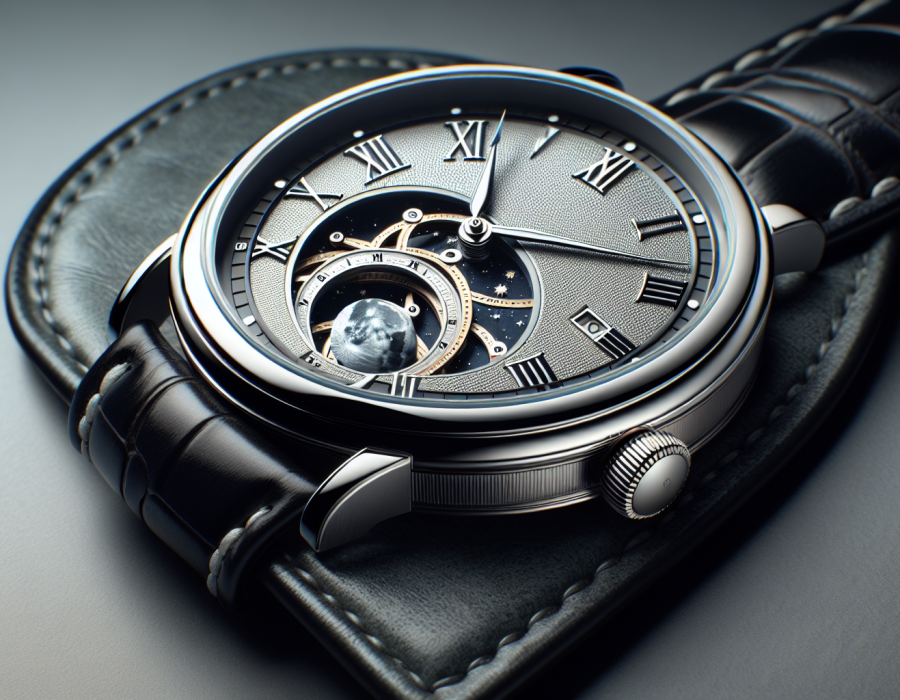Moonphase watches represent a splendid marriage of high horology and the celestial dance of the cosmos. These timepieces display the current phase of the moon as it waxes and wanes, offering not only the practicality of timekeeping but also the poetic reflection of the night sky on your wrist. Moonphase watches typically showcase a small aperture on the dial through which a disc rotates, illustrating the visible portion of the moon as seen from Earth. This enchanting feature, often set against a starry backdrop, makes the moonphase watch a romantic and intriguing accessory.
The historical significance of moonphase watches is deeply rooted in the annals of timekeeping. Prior to the age of advanced technology, lunar phases played a critical role in navigation, agriculture, and the marking of time and festivals. Master watchmakers of the past sought to encapsulate the lunar cycle into the precision of mechanical watches, making moonphase complications some of the earliest examples of complex watchmaking. These timepieces became emblems of sophistication and intellect, flaunted by connoisseurs and astronomers alike.
The appeal and aesthetics of moonphase watches are manifold. Part of their allure lies in the visual harmony and classical elegance they bring to the watch face. The moon, often represented in polished metals or enamels, adds an extra dimension to a watch's display, creating a sense of depth and artistry. For many enthusiasts, moonphase watches transcend their functional use, becoming a symbol of the cyclical nature of time and the enigmatic pull that the moon exerts over human sentiment and sensibility.
The Craftsmanship Behind Moonphase Watches
Crafting moonphase watches requires a blend of indomitable horological expertise and meticulous attention to detail. The mechanisms and movements responsible for mirroring the lunar cycle involve a series of gears calibrated to reflect the moon's roughly 29.5-day progression. This intricate complication needs to operate with unwavering precision; a single error in gear arrangement can lead to an inaccurate moonphase display, diminishing the prestige and value of the watch.
Master watchmakers employ their virtuosity in the mechanics and aesthetics of moonphase timepieces. These artisans pay homage to a storied tradition by handcrafting each delicate component and ensuring the harmonious movement of gears. The visual elements of the moonphase dial are often the result of painstaking hand-painting or engraving, demanding an artist's touch and reinforcing the watch's status as a wearable piece of art. The dedication to this art form reinforces the moonphase watch's status not merely as an accessory, but as a testament to human artistry.
Materials and durability are equally critical in the construction of moonphase watches. Premium metals such as gold, platinum, and surgical-grade stainless steel often form the case and intricate components within the movement. Sapphires and other scratch-resistant materials might grace the dial window to ensure longevity. The delicate moonphase complication depends on the resilience of these materials and the protective craftsmanship of the watch case to endure the test of time, just like the enduring celestial body they track.
Iconic Brands and Models
Patek Philippe, Audemars Piguet, and Jaeger-LeCoultre are revered names that resonate throughout the watchmaking world, particularly in the realm of moonphase watches. Patek Philippe's Celestial series is a marvel of horological engineering and design. These sumptuous watches go beyond the conventional moonphase display; they depict the night sky as it appears over Geneva, complete with the motion of the stars and the moon. The celestial ballet on the wrist is remarkably accurate, reflective of Patek Philippe's uncompromising dedication to craftsmanship.
The Royal Oak Moonphase by Audemars Piguet stands as an icon of modern watchmaking. With a design that reshaped the landscape of luxury watches, the Royal Oak incorporates a moonphase complication into the legendary octagonal bezel and integrated bracelet design with an elegance that defies convention. The starkness of the Royal Oak's aesthetic paired with the romance of the moonphase produces a watch that is as bold as it is beautiful.
Jaeger-LeCoultre's Master Ultra Thin Moon is another distinguished member of this celestial ensemble. This watch exemplifies the brand's expertise in creating ultra-thin movements, housing the moonphase complication within a slender, refined case. The blending of traditional design and contemporary thinness results in a timepiece that is both discreet and eye-catching, a fitting homage to the discreet luminescence of the moon itself.
How Moonphase Watches Work
The secret behind the charm of moonphase watches lies in the elaborate moonphase complication. This feature is a small mechanical representation that shows the lunar cycle by emulating the moon's orbit around the Earth. A disk adorned with two identical moons rotates beneath an aperture on the watch face. This rotation is typically driven by a 59-tooth gear that advances one notch per day, completing a full cycle in approximately two lunar months. The interplay of precise gearing results in a display that closely tracks the 29.5 days of the moon’s phases, often requiring only a single day's correction once every few years.
Accuracy is the cornerstone of a superior moonphase watch. Manufacturers pride themselves on crafting complications that closely mimic the moon's actual cycle, understanding that even slight deviations can compound over time. To maintain the poetic precision that defines these horological masterpieces, watchmakers continually refine their movements and gearing systems. As a result, modern moonphase watches are capable of astonishingly accurate depictions, sometimes requiring correction only once every century or more.
For enthusiasts, setting and maintaining a moonphase watch is part of the allure. By consulting lunar charts or an accurate electronic source, one sets the moonphase complication to the current phase. This process involves rotating the moon-phase disk until it reflects the sky above, a satisfying ritual for those inclined towards the intricacies of mechanical timekeeping. The enduring appeal of this interaction lies in the personal connection it fosters between the wearer and the celestial rhythms that govern our natural world.
Owning a Moonphase Watch
Owning a moonphase watch is a decision imbued with both practical and emotional considerations. On the practical side, potential buyers must weigh the price and investment value. High-end moonphase watches can command considerable sums, reflective of their intricate mechanics and the prestige of their heritage brands. These watches are not merely timepieces; they are investments in craftsmanship and history, with some models appreciating over time.
When considering a moonphase watch, one's style and personal preference are paramount. From the ornate and classical to the sleek and modern, moonphase watches offer designs to suit any aesthetic. Some may prefer a minimalist dial that allows the moonphase feature to stand out, while others might seek the embellishment of diamond-set bezels or hand-painted dials. The choice of a moonphase watch is a reflection of the owner's identity and his or her connection to time's poetic dimensions.
Maintenance and care of a moonphase watch are as critical as the initial purchase. The complex internals require regular servicing by a professional to ensure accuracy and longevity. The external components, such as the case and crystal, also need attention to withstand the rigors of daily wear. An owner must commit to both the financial and temporal demands of a moonphase watch, keeping in mind that this commitment is rewarded by the timepiece’s enduring beauty and mechanical wonder.
Prospective owners should also consider the pros and cons of purchasing a moonphase watch. While offering an unmatched elegance and connection to the celestial realm, moonphase watches may demand higher maintenance and bear a premium cost compared to simpler timepieces. The buyer must seek a balance between the allure of a moonphase complication and practical watch ownership considerations, such as the frequency of use, care requirements, and personal value attributed to such a sophisticated horological feature.
The Future of Moonphase Watches
In the realm of luxury timepieces, moonphase watches remain a testament to human ingenuity, blending ancient skywatching traditions with modern technological advances. Innovations continue to emerge, with manufacturers incorporating more precise movements and exploring new materials to augment the moonphase mechanism's durability and aesthetic appeal. Advances in metallurgy and synthetic sapphire production, for example, offer new opportunities to improve the precision and longevity of these timeless pieces.
Design trends also come into play regarding the future collectibility and appeal of moonphase watches. As tastes evolve, so too may the appearance of these celestial timepieces. New interpretations of the classic moonphase dial, integration with other complications, and daring aesthetic innovations may all contribute to the evolution and enduring desirability of moonphase watches among collectors and enthusiasts.
The significance of moonphase watches in modern times extends beyond their function as precision timekeepers. In an age of digital ubiquity, they stand as ambassadors of a quieter, more reflective understanding of time. They remind us of our shared history under the night sky and the importance of marking time not just in hours and minutes, but in the rhythm of the cosmos. Moonphase watches continue to entrance and inspire, a testament to the never-ending human quest to chart the mysteries of the heavens and the passage of time.
In conclusion, the moonphase watch represents a fascinating intersection of art, science, craftsmanship, and history. As a celebration of celestial mechanics and aesthetic beauty, it holds a special place in the prestige of horological achievements, enchanting collectors and watch aficionados worldwide. The future of moonphase watches seems as bright and enduring as the lunar glow they so elegantly emulate, promising continued innovation, appeal, and inspiration in the intricate tapestry of timekeeping masterpieces.






Comments